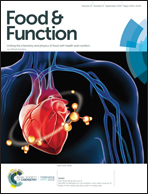γ-[Glu]n-Trp ameliorates anxiety/depression-like behaviors and its anti-inflammatory effect in an animal model of anxiety/depression
Abstract
This study compared the abilities of γ-[Glu]n-Trp (EW) and whey protein hydrolysate (WPH) with a high ratio of Trp : 5 large neutral amino acids (5LNAAs) to reverse chronic restraint stress-corticosterone injection induced anxiety/depression-like behaviors in C57BL/6 male mice. EW was synthesized using L-glutaminase from Bacillus amyloliquefaciens. Acid protease, trypsin, pancreatin or flavorzyme was used to produce WPHs. The WPH with the highest Trp/5LNAAs ratio (17.38%; by trypsin) was selected for animal trials. EW (dose 2.0, 5.0 or 10.0 mg kg−1 d−1) and WPH (dose 0.5, 1.0 or 2.0 mg g−1 d−1) reversed behavioral dysfunctions, suppressed serum inflammatory cytokines (TNF-α, IL-6, IL-1β and IFN-γ), and reduced the activity of indoleamine 2,3-dioxygenase (key rate-limiting enzyme of the kynurenine pathway) while increasing the activity of tryptophan hydroxylase (key rate-limiting enzyme of the serotonin pathway) in the hypothalamus, hippocampus and prefrontal cortex, with EW acting more effectively. EW could also increase body weight gain and might act more effectively via the kynurenine pathway. These findings are of significance to promote the future practical application of kokumi γ-[Glu]n-Trp peptides.
![Graphical abstract: γ-[Glu]n-Trp ameliorates anxiety/depression-like behaviors and its anti-inflammatory effect in an animal model of anxiety/depression](/en/Image/Get?imageInfo.ImageType=GA&imageInfo.ImageIdentifier.ManuscriptID=C9FO01467E&imageInfo.ImageIdentifier.Year=2019)


 Please wait while we load your content...
Please wait while we load your content...